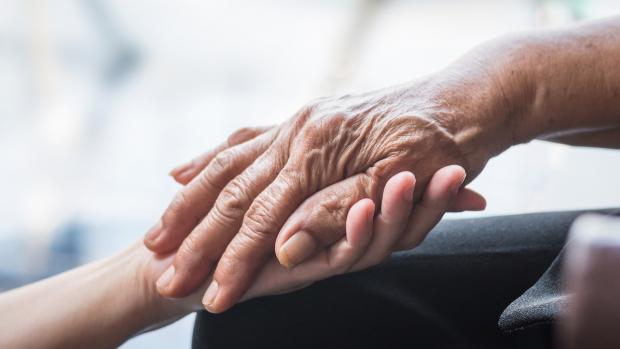Fighting hand tremors: First comes AI, then robots
Researchers from NYU and Canada develop a machine learning model that allows robots to safely treat symptoms of Parkinson’s disease and other neurological movement disorders

BROOKLYN, New York, Wednesday, March 4, 2020 – Robots hold promise for a large number of people with neurological movement disorders severely affecting the quality of their lives. Now researchers have tapped artificial intelligence techniques to build an algorithmic model that will make the robots more accurate, faster, and safer when battling hand tremors.
Their model, which is ready for others to deploy, appears this month in Scientific Reports, an online journal of Nature. The international team reports the most robust techniques to date to characterize pathological hand tremors symptomatic of the common and debilitating motor problems affecting a large number of aging adults. One million people throughout the world have been diagnosed with Parkinson’s disease, just one of the neurodegenerative diseases that can cause hand tremors.
While technology such as sophisticated wearable exoskeleton suits and neurorehabilitative robots could help people offset some involuntary movements, these robotic assistants need to precisely predict involuntary movements in real-time — a lag of merely 10 or 20 milliseconds can thwart effective compensation by the machine and in some cases may even jeopardize safety.
Enter the big dataset collected at the London (Ontario) Movement Disorders Centre and the team's pioneering machine learning model, which they named PHTNet, for "Pathological Hand Tremors using Recurrent Neural Networks." Using small sensors, they analyzed the hand motions of 81 patients in their 60s and 70s, then applied a novel data-driven deep neural network modeling technique to extract predictive information applicable to all patients.
Their paper details the artificial intelligence model and training, and reports a 95% confidence rate over 24,300 samples.
“Our model is already at the ready-to-use stage, available to neurologists, researchers, and assistive technology developers,” said co-author S. Farokh Atashzar, who is now an NYU Tandon assistant professor and who began exploring the use of robots coupled with artificial intelligence while conducting doctoral and post-doctoral research in Canada. “It requires substantial computational power, so we plan to develop a low-power, cloud-computing approach that will allow wearable robots and exoskeletons to operate in patients’ homes. We also hope to develop models that require less computational power and add other biological factors to the inputs.”
“PHTNet: Characterization and Deep Mining of Involuntary Pathological Hand Tremor Using Recurrent Neural Network Models” is available at www.nature.com/articles.
The collaboration began in 2014 with researchers from the University of Western Ontario (UWO), Lawson Health Research Institute, and the London Health Sciences Centre; others from Concordia University in Montreal subsequently joined.
Along with Atashzar, co-authors of this paper include corresponding author Arash Mohammadi, a Concordia University professor; Rajni Patel, a University of Western Ontario professor and director of engineering at Canadian Surgical Technologies and Advanced Robotics (CSTAR); and Mandar Jog, a University of Western Ontario professor, director of the Parkinson’s Foundation Centre of Excellence in Movement Disorders, and a neurologist at the London Movement Disorders Centre. Soroosh Shahtalebi, a Concordia University doctoral student, is the first author of the paper. Doctoral student Olivia Samotus of the London Movement Disorders Centre and the University of Western Ontario collected the hand tremor data and is also a co-author of the paper.
The Natural Sciences and Engineering Research Council (NSERC) of Canada provided financial support for the research.
Atashzar holds appointments at NYU Tandon’s Department of Mechanical and Aerospace Engineering and Department of Electrical and Computer Engineering and is on the faculty of the NYU WIRELESS research center.
About the New York University Tandon School of Engineering
The NYU Tandon School of Engineering dates to 1854, the founding date for both the New York University School of Civil Engineering and Architecture and the Brooklyn Collegiate and Polytechnic Institute (widely known as Brooklyn Poly). A January 2014 merger created a comprehensive school of education and research in engineering and applied sciences, rooted in a tradition of invention and entrepreneurship and dedicated to furthering technology in service to society. In addition to its main location in Brooklyn, NYU Tandon collaborates with other schools within NYU, one of the country’s foremost private research universities, and is closely connected to engineering programs at NYU Abu Dhabi and NYU Shanghai. It operates Future Labs focused on start-up businesses in Brooklyn and an award-winning online graduate program. For more information, visit engineering.nyu.edu.
About NYU WIRELESS
NYU WIRELESS is a vibrant academic research center that is pushing the boundaries of wireless communications, sensing, networking, and devices. Centered at NYU Tandon and involving leaders from industry, faculty, and students throughout the entire NYU community, NYU WIRELESS offers its industrial affiliates, students, and faculty members a world-class research environment that is creating fundamental knowledge, theories, and techniques for future mass-deployable wireless devices across a wide range of applications and markets. Every April, NYU WIRELESS hosts a major invitation-only wireless summit, in cooperation with Nokia Bell Laboratories, for the center’s industrial affiliates and thought leaders throughout the global telecommunications industry. For more information, visit wireless.engineering.nyu.edu.




